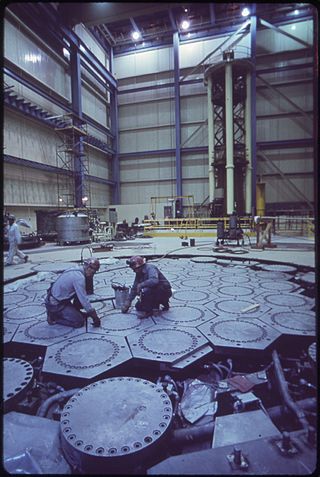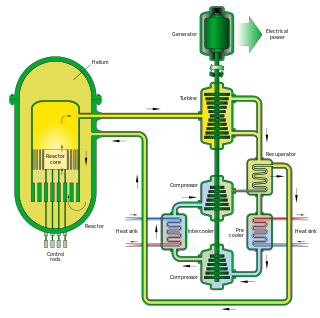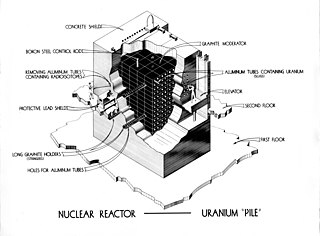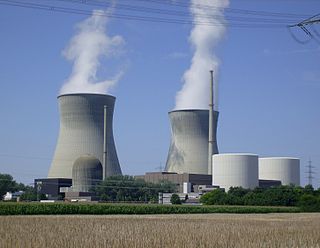
A nuclear reactor is a device used to initiate and control a fission nuclear chain reaction or nuclear fusion reactions. Nuclear reactors are used at nuclear power plants for electricity generation and in nuclear marine propulsion. Heat from nuclear fission is passed to a working fluid, which in turn runs through steam turbines. These either drive a ship's propellers or turn electrical generators' shafts. Nuclear generated steam in principle can be used for industrial process heat or for district heating. Some reactors are used to produce isotopes for medical and industrial use, or for production of weapons-grade plutonium. As of 2022, the International Atomic Energy Agency reports there are 422 nuclear power reactors and 223 nuclear research reactors in operation around the world.

The pebble-bed reactor (PBR) is a design for a graphite-moderated, gas-cooled nuclear reactor. It is a type of very-high-temperature reactor (VHTR), one of the six classes of nuclear reactors in the Generation IV initiative.

The Pebble Bed Modular Reactor (PBMR) is a particular design of pebble bed reactor developed by South African company PBMR (Pty) Ltd from 1994 until 2009. PBMR facilities include gas turbine and heat transfer labs at the Potchefstroom Campus of North-West University, and at Pelindaba, a high pressure and temperature helium test rig, as well as a prototype fuel fabrication plant. A planned test reactor at Koeberg Nuclear Power Station was not built.

Rudolf Schulten —professor at RWTH Aachen University—was the main developer of the pebble bed reactor design, which was originally invented by Farrington Daniels. Schulten's concept compacts silicon carbide-coated uranium granules into hard, billiard-ball-like graphite spheres to be used as fuel for a new high temperature, helium-cooled type of nuclear reactor.

A molten salt reactor (MSR) is a class of nuclear fission reactor in which the primary nuclear reactor coolant and/or the fuel is a mixture of molten salt with a fissionable material.
Generation IVreactors are nuclear reactor design technologies that are envisioned as successors of generation III reactors. The Generation IV International Forum (GIF) – an international organization that coordinates the development of generation IV reactors – specifically selected six reactor technologies as candidates for generation IV reactors. The designs target improved safety, sustainability, efficiency, and cost. The World Nuclear Association in 2015 suggested that some might enter commercial operation before 2030.

A high-temperature gas-cooled reactor (HTGR) is a type of gas-cooled nuclear reactor which use uranium fuel and graphite moderation to produce very high reactor core output temperatures. All existing HTGR reactors use helium coolant. The reactor core can be either a "prismatic block" or a "pebble-bed" core. China Huaneng Group currently operates HTR-PM, a 250 MW HTGR power plant in Shandong province, China.

The gas-cooled fast reactor (GFR) system is a nuclear reactor design which is currently in development. Classed as a Generation IV reactor, it features a fast-neutron spectrum and closed fuel cycle for efficient conversion of fertile uranium and management of actinides. The reference reactor design is a helium-cooled system operating with an outlet temperature of 850 °C (1,560 °F) using a direct Brayton closed-cycle gas turbine for high thermal efficiency. Several fuel forms are being considered for their potential to operate at very high temperatures and to ensure an excellent retention of fission products: composite ceramic fuel, advanced fuel particles, or ceramic clad elements of actinide compounds. Core configurations are being considered based on pin- or plate-based fuel assemblies or prismatic blocks, which allows for better coolant circulation than traditional fuel assemblies.

A graphite-moderated reactor is a nuclear reactor that uses carbon as a neutron moderator, which allows natural uranium to be used as nuclear fuel.

Dragon was an experimental high temperature gas-cooled reactor at Winfrith in Dorset, England, operated by the United Kingdom Atomic Energy Authority (UKAEA). Its purpose was to test fuel and materials for the European High Temperature Reactor programme, which was exploring the use of tristructural-isotropic (TRISO) fuel and gas cooling for future high-efficiency reactor designs. The project was built and managed as an Organisation for Economic Co-operation and Development/Nuclear Energy Agency international project. In total, 13 countries were involved in its design and operation during the project lifetime.

Nuclear power was used in Germany from the 1960s until it was phased out in April 2023.

HTR-10 is a 10 MWt prototype high-temperature gas-cooled, pebble-bed reactor at Tsinghua University in China. Construction began in 1995, achieving its first criticality in December 2000, and was operated in full power condition in January 2003.

The AVR reactor was a prototype pebble-bed reactor, located immediately adjacent to Jülich Research Centre in West Germany, constructed in 1960, grid connected in 1967 and shut down in 1988. It was a 15 MWe, 46 MWt test reactor used to develop and test a variety of fuels and machinery.
A gas-cooled reactor (GCR) is a nuclear reactor that uses graphite as a neutron moderator and a gas as coolant. Although there are many other types of reactor cooled by gas, the terms GCR and to a lesser extent gas cooled reactor are particularly used to refer to this type of reactor.

The Gundremmingen Nuclear Power Plant was a nuclear power station in Germany. It was located in Gundremmingen, district of Günzburg, Bavaria. It was operated by Kernkraftwerk Gundremmingen GmbH, a joint operation of RWE Power AG (75%) and PreussenElektra (25%). Unit B was shut down at the end of 2017. Unit C, the last boiling water reactor in Germany, was shut down on New Year's Eve 2021, as part of the German nuclear phase out. However, Gundremmingen unit C as well as the other two German nuclear reactors shut down that day remain capable of restarting operations as of March 2022. In November 1975, Unit A was the site of the first fatal accident in a nuclear power plant and subsequently of a major incident resulting in a total loss in 1977.

Obrigheim Nuclear Power Plant (KWO) is a nuclear power plant currently in the decommissioning phase. The plant is located in Obrigheim, Neckar-Odenwald-Kreis, on the banks of the Neckar and owned by EnBW. It operated a pressurized water reactor unit from 1969 to 2005. The defuelling process was completed in 2007, with spent fuel rods awaiting transport to an interim storage facility. In March 2017, EnBW tested the shipment of numerous castors by a barge on the Neckar to Neckarwestheim Nuclear Power Plant.

The liquid fluoride thorium reactor is a type of molten salt reactor. LFTRs use the thorium fuel cycle with a fluoride-based molten (liquid) salt for fuel. In a typical design, the liquid is pumped between a critical core and an external heat exchanger where the heat is transferred to a nonradioactive secondary salt. The secondary salt then transfers its heat to a steam turbine or closed-cycle gas turbine.
The HTR-PM is a Chinese small modular nuclear reactor. It is a high-temperature gas-cooled (HTGR) pebble-bed generation IV reactor based on the German AVR design. The technology is intended to replace coal-fired power plants in China's interior, in line with the country's plan to reach carbon neutrality by 2060.
U-battery is a micro–small modular reactor design of a nuclear reactor.
















